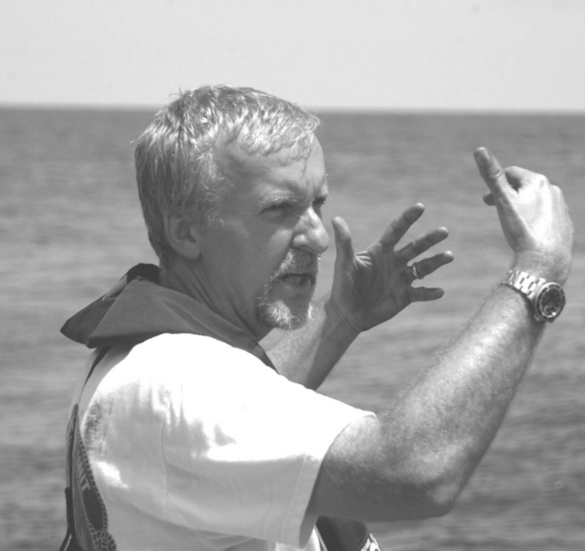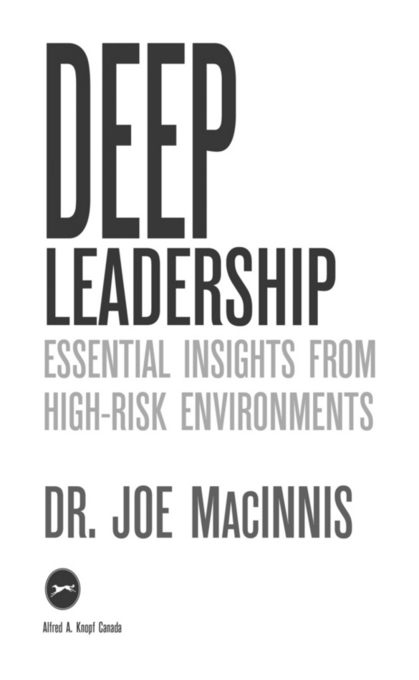More advance praise for
DEEP LEADERSHIP
A celebrated Canadian explorer has written a book about the straight, stark reality of influencing others while pushing the limits of human performance. Here are important messages to help each of us on our lifelong leadership journey.
Dave Williams, shuttle astronaut STS-90 and STS-118
Dr. Joe MacInnis personifies the marrow of true leadership: when he believes in you you believe in yourself. Here is an invaluable guide on how to exercise command and achieve resultsfrom the depth of the high Arctic to the summits of the office towers piercing the urban skies.
Peter C. Newman, bestselling author
Dr. Joe MacInnis brings a unique perspective to the subject of leadership. Hes lived inside its fire with men and women who perform dangerous, meaningful tasks on behalf of science or their country. This is an insiders view of a critically important area of human performance.
Col. Bill Bentley, Director, Canadian Forces Leadership Institute
Decades ago I dove under the ice at the North Pole with Dr. Joe and witnessed his unique style of leadership. In this riveting and informative book he takes you from the abyssal ocean to the moon and backand reveals essential leadership qualities from the likes of Pierre Trudeau, Kathy Sullivan, James Cameron and Buzz Aldrin.
Gilbert M. Grosvenor, fourth president of the National Geographic Society
From the first science dives at the North Pole to the exploration of RMS Titanic at the bottom of the Atlantic Ocean, few humans have had Joe MacInniss range of high-risk experiences. His insights, tested in the fire of real-life challenges, are invaluable to every aspiring leader.
David Peterson, twentieth premier of Ontario
A highly personal look at that special breed, from president John F. Kennedy to filmmaker James Cameron to journalist Walter Cronkite, who live by the code of leadership. This is an inspired read.
Sven-Olof Lindblad, CEO, Lindblad Expeditions
Also by Dr. Joe MacInnis
Breathing Underwater: The Quest to Live in the Sea
James Camerons Aliens of the Deep
Saving the Ocean (General Editor)
The Land That Devours Ships
Titanic in a New Light
Surviving Terrorism
Underwater Images
Fitzgeralds Storm
Underwater Man
Titanic Dreams
PUBLISHED BY ALFRED A. KNOPF CANADA
Copyright 2012 Dr. Joe MacInnis
All rights reserved under International and Pan-American Copyright Conventions. No part of this book may be reproduced in any form or by any electronic or mechanical means, including information storage and retrieval systems, without permission in writing from the publisher, except by a reviewer, who may quote brief passages in a review. Published in 2012 by Alfred A. Knopf Canada, a division of Random House of Canada Limited, Toronto. Distributed in Canada by Random House of Canada Limited.
www.randomhouse.ca
Knopf Canada and colophon are registered trademarks.
LIBRARY AND ARCHIVES CANADA CATALOGUING IN PUBLICATION
MacInnis, Joe, 1937
Deep leadership: Essential Insights from High-Risk Environments / Joe MacInnis.
eISBN: 978-0-307-36112-7
1. Leadership. 2. MacInnis, Joe, 1937 Anecdotes. I. Title.
HM1261.M33 2012 303.34 C2011-904640-7
Cover design by Andrew Roberts
Cover image: Jeff Rotman/Digital Vision/Getty Images
v3.1
CONTENTS

Jim Cameron on the deck of the ship EDT Ares.
SEARCHING FOR THE ESSENCE OF LEADERSHIP
JAMES CAMERON , the acclaimed Hollywood director, applies his leadership skills in the most intriguing places. Ive seen him choreographing actors, lighting experts, and computer operators on the set of Avatar in Los Angeles. Ive watched him coordinate scientists, cameramen, and sub-pilots on research ships in the North Atlantic. But in 2010, in a third floor conference room in the EPA building in Washington, I saw him confront a different kind of challenge.
The rectangular room had cherrywood walls, big-frame video screens, and sunlight streaming through a south-facing window. There were twenty-two men and women, sitting around a long table with laptop computers open in front of us. Dressed in a blue open-collar shirt, Cameron welcomed us to the meeting.
Thanks for coming and spending the day with us. Thanks for taking the time to brainstorm a really tough problem.
The problem was Deepwater Horizon, a runaway oil well five thousand feet under the ocean. After repeated attempts, the four companies responsible for the blowout had failed to cap the well. Millions of barrels of oil had escaped and the northeast section of the Gulf of Mexico was turning into a biological black hole.
Around the table were deep-sea experts from Woods Hole Oceanographic, Harbor Branch Oceanographic, NOAA, the University of California, and the Russian Academy of Sciences. They were men and women who had logged hundreds of hours beneath the sea at depths greater than five thousand feet and could easily imagine what was taking place beneath the surface of the Gulf.
It was a great dying that no one could see. Hundreds of cubic miles of seawater were filling with ragged black columns, thick streams, and small droplets of oil. For weeks, an enormous, expanding fog of oil had been enveloping the larvae and newborn of snapper, dolphin, lobster, billfish, and bluefin tuna. The prodigy of death and mutilations in young and mature animals included eye wounds, gill wounds, stomach wounds, gelatinous tissue wounds, and oxygen-deprived metabolisms.
The killing continued right up to the surface where phytoplanktonthe lungs of the planetwere savaged by the violence of the oil and the chemicals used to disperse it. Trillions and trillions of dead microorganisms rained down through the filthy procession of upward-moving oil. In deep water they merged with the uncounted corpses of crustaceans and in deeper water still, the remnants of big fish, small fish, turtles and invertebrates. The deluge of megadeath continued until the lifeless remains came to rest on the brown floor of the Gulf.
Unprepared for what was happening beneath their ships, senior managers were slow to respond. Their hapless attempts to contain the well included the deployment of a useless four-storey containment vessel and a bizarre top-kill operation using golf balls and mud. Tony Hayward, BPs CEO, was saying all the wrong things: The environmental impact is likely to be very, very modest, he whispered hoarsely at an early news conference. A few weeks later he remarked, Nobody wants this over more than I do. I want my life back.
The stark truth was that BP had no emergency plan for the worst environmental disaster in American history. There were no containment systems and no rapid response teams ready to deal with such an unprecedented event. There was a severe lack of strategic leadership.
BP has a hundred engineers working on this, continued Cameron, so its unlikely well come up with technical options they havent thought of. But we owe it to ourselves, and the ocean, to do some hard thinking about future responses of the scientific community.











